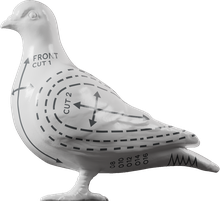Fashion — 1914-1920
Jumper-blouse
This silk blouse, jumper or ‘jumper-blouse’ perfectly represents the everyday fashions that evolved in Britain during the First World War and were worn by many women at the start of the 1920s.
It was worn by a member of the Rippon family, and was donated to the London Museum by Mrs V. Rippon in 1963.
Blouse-like garments were widely worn by women from the end of the nineteenth century but became increasingly popular during the war years due to their affordability, adaptability and practicality. They were made from both woven and knitted fabrics, in natural and synthetic materials, often with some simple decoration of embroidery, lace or other trimmings. Blouses were one of the first garments to benefit from the modern factory methods of mass-production, meaning they were an affordable purchase for women of different socio-economic backgrounds. They were also simple to make at home, and many magazines offered tutorials for making up simple blouse and jumper styles.
The terms ‘jumper’ and ‘jumper-blouse’ came into use during the war for garments that resembled a blouse but could be worn over (rather than tucked into) a skirt. This coral coloured garment would have been worn in this way, likely layered over a plain skirt for day-time wear. This loose, layered look was typical of the fashionable boyish silhouette at the turn of the decade, and is echoed in the more famous ‘flapper’ dresses of the 1920s. Jumpers and jumper-blouses were also made without fastenings and were simply pulled on over the head. The term ‘jumper-blouse’ was soon forgotten and jumpers could generally be differentiated from blouses by the materials used; knits for the former and wovens for the latter.
This garment may have been professionally or home-made; the quality of the machine- and hand-stitching on the seams is very good but the decorative embroidery has been more crudely executed. The sleeves and body have been cut from one piece of coral coloured silk crepe, with a wide band of dark red knitted jersey inserted at waist level on body and sleeves. A small fall collar has been added to the V-shaped neckline. Cross-stitched squares in pink and white floss decorate the bodice, sleeves and collar, front and back, each centred with a single red bead. The maker offered further flexibility in the garment by providing an optional belt that could be attached via snap fastening at the centre back and tied around the waist.
Blouses, jumpers and jumper-blouses such as this played a vital role in the casualization of women’s dress in the 1910s, paving the way for the comparatively relaxed fashions of the 1920s. They enabled women to mix-and-match items from their wardrobes rather than wearing primarily matching or coordinated ensembles, and were soon worn for everything from office work to evening theatre visits. Though simple, this garment represents a moment of significant change in women’s dressing practices.
- Category:
- Fashion
- Object ID:
- 63.83/42
- Object name:
- jumper-blouse
- Object type:
- Artist/Maker:
- —
- Related people:
- Related events:
- Related places:
- Production date:
- 1914-1920
- Material:
silk
- Measurements/duration:
- L 628 mm (overall), W 485 mm (armpit to armpit), W 495 mm (hem, full extent) (overall)
- Part of:
- —
- On display:
- —
- Record quality:
- 100%
- Part of this object:
- —
- Owner Status & Credit:
Permanent collection
- Copyright holder:
unknown
- Image credit:
- —
- Creative commons usage:
- —
- License this image:
To license this image for commercial use, please contact the London Museum Picture Library.

